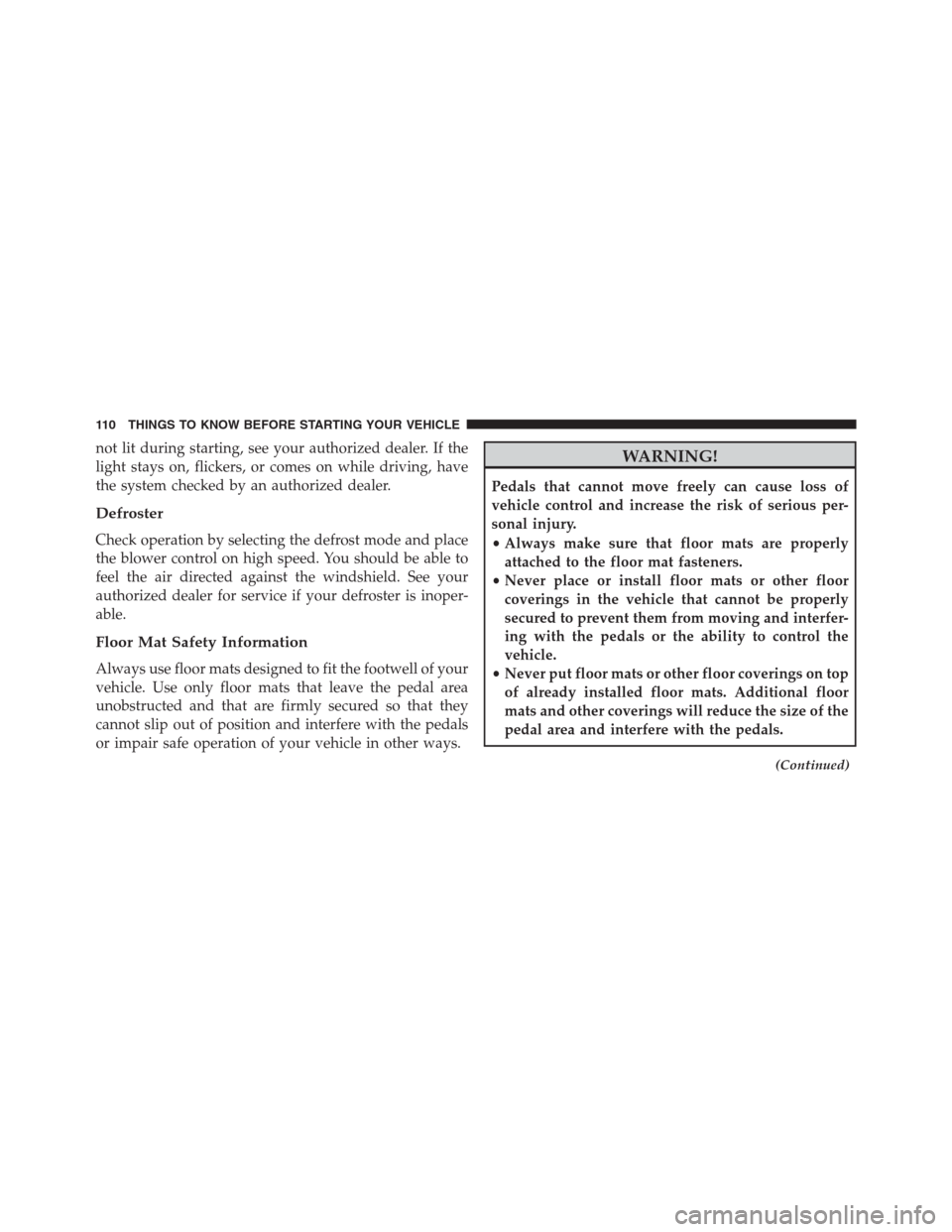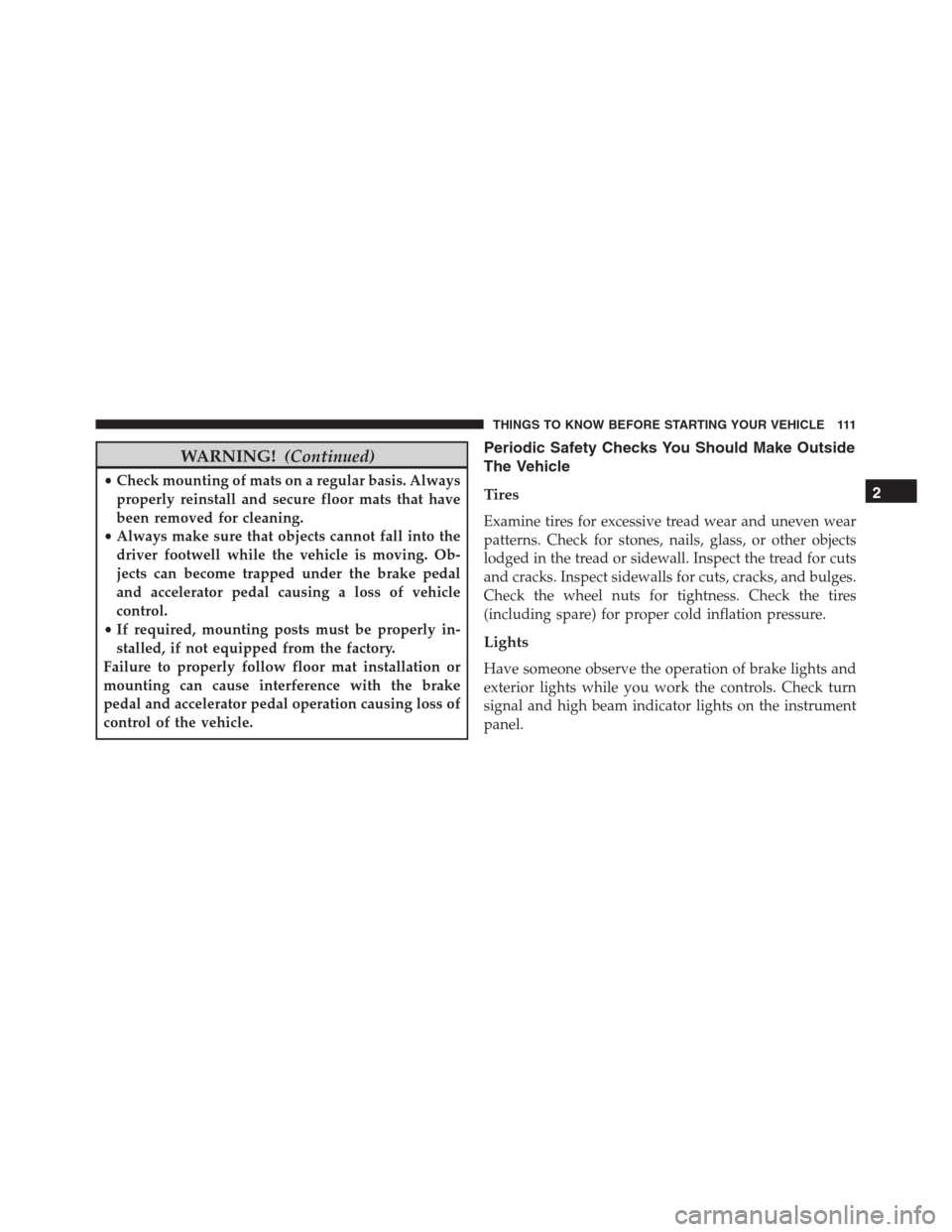Page 81 of 636

The ORC contains a backup power supply system that
may deploy the air bags even if the battery loses power or
it becomes disconnected prior to deployment.
The ORC turns on the Air Bag Warning Light in the
instrument panel for approximately four to eight seconds
for a self-check when the ignition is first placed in the
ON/RUN position. After the self-check, the Air Bag
Warning Light will turn off. If the ORC detects a mal-
function in any part of the system, it turns on the Air Bag
Warning Light, either momentarily or continuously. A
single chime will sound to alert you if the light comes on
again after initial startup.
The ORC also includes diagnostics that will illuminate
the instrument panel Air Bag Warning Light if a malfunc-
tion is detected that could affect the air bag system. The
diagnostics also record the nature of the malfunction.
While the air bag system is designed to be maintenancefree, if any of the following occurs, have an authorized
dealer service the air bag system immediately.
•The Air Bag Warning Light does not come on during
the four to eight seconds when the ignition is first
placed in the ON/RUN position.
•The Air Bag Warning Light remains on after the four to
eight-second interval.
•The Air Bag Warning Light comes on intermittently or
remains on while driving.
NOTE:If the speedometer, tachometer, or any engine
related gauges are not working, the Occupant Restraint
Controller (ORC) may also be disabled. In this condition
the air bags may not be ready to inflate for your protec-
tion. Have an authorized dealer service the air bag
system immediately.
2
THINGS TO KNOW BEFORE STARTING YOUR VEHICLE 79
Page 82 of 636

WARNING!
Ignoring the Air Bag Warning Light in your instru-
ment panel could mean you won’t have the air bags
to protect you in a collision. If the light does not come
on as a bulb check when the ignition is first placed in
the on position, and stays on after you start the
vehicle, or if it comes on as you drive, have an
authorized dealer service the air bag system immedi-
ately.
Maintaining Your Air Bag System
WARNING!
•Modifications to any part of the air bag system
could cause it to fail when you need it. You could
be injured if the air bag system is not there to
(Continued)
WARNING!(Continued)
protect you. Do not modify the components or
wiring, including adding any kind of badges or
stickers to the steering wheel hub trim cover or the
upper right side of the instrument panel. Do not
modify the front bumper, vehicle body structure, or
add aftermarket side steps or running boards.
•It is dangerous to try to repair any part of the air
bag system yourself. Be sure to tell anyone who
works on your vehicle that it has an air bag system.
•Do not attempt to modify any part of your air bag
system. The air bag may inflate accidentally or may
not function properly if modifications are made.
Take your vehicle to an authorized dealer for any
air bag system service. If your seat, including your
trim cover and cushion, needs to be serviced in any
way (including removal or loosening/tightening of
(Continued)
80 THINGS TO KNOW BEFORE STARTING YOUR VEHICLE
Page 111 of 636

The best protection against carbon monoxide entry into
the vehicle body is a properly maintained engine exhaust
system.
Whenever a change is noticed in the sound of the exhaust
system, when exhaust fumes can be detected inside the
vehicle, or when the underside or rear of the vehicle is
damaged, have a competent mechanic inspect the com-
plete exhaust system and adjacent body areas for broken,
damaged, deteriorated, or mispositioned parts. Open
seams or loose connections could permit exhaust fumes
to seep into the passenger compartment. In addition,
inspect the exhaust system each time the vehicle is raised
for lubrication or oil change. Replace as required.Safety Checks You Should Make Inside The
Vehicle
Seat Belts
Inspect the seat belt system periodically, checking for
cuts, frays, and loose parts. Damaged parts must be
replaced immediately. Do not disassemble or modify the
system.
Front seat belt assemblies must be replaced after a
collision. Rear seat belt assemblies must be replaced after
a collision if they have been damaged (i.e., bent retractor,
torn webbing, etc.). If there is any question regarding seat
belt or retractor condition, replace the seat belt.
Air Bag Warning Light
The light should come on and remain on for
four to eight seconds as a bulb check when the
ignition switch is first turned ON. If the light is
2
THINGS TO KNOW BEFORE STARTING YOUR VEHICLE 109
Page 112 of 636

not lit during starting, see your authorized dealer. If the
light stays on, flickers, or comes on while driving, have
the system checked by an authorized dealer.
Defroster
Check operation by selecting the defrost mode and place
the blower control on high speed. You should be able to
feel the air directed against the windshield. See your
authorized dealer for service if your defroster is inoper-
able.
Floor Mat Safety Information
Always use floor mats designed to fit the footwell of your
vehicle. Use only floor mats that leave the pedal area
unobstructed and that are firmly secured so that they
cannot slip out of position and interfere with the pedals
or impair safe operation of your vehicle in other ways.
WARNING!
Pedals that cannot move freely can cause loss of
vehicle control and increase the risk of serious per-
sonal injury.
•Always make sure that floor mats are properly
attached to the floor mat fasteners.
•Never place or install floor mats or other floor
coverings in the vehicle that cannot be properly
secured to prevent them from moving and interfer-
ing with the pedals or the ability to control the
vehicle.
•Never put floor mats or other floor coverings on top
of already installed floor mats. Additional floor
mats and other coverings will reduce the size of the
pedal area and interfere with the pedals.
(Continued)
110 THINGS TO KNOW BEFORE STARTING YOUR VEHICLE
Page 113 of 636

WARNING!(Continued)
•Check mounting of mats on a regular basis. Always
properly reinstall and secure floor mats that have
been removed for cleaning.
•Always make sure that objects cannot fall into the
driver footwell while the vehicle is moving. Ob-
jects can become trapped under the brake pedal
and accelerator pedal causing a loss of vehicle
control.
•If required, mounting posts must be properly in-
stalled, if not equipped from the factory.
Failure to properly follow floor mat installation or
mounting can cause interference with the brake
pedal and accelerator pedal operation causing loss of
control of the vehicle.
Periodic Safety Checks You Should Make Outside
The Vehicle
Tires
Examine tires for excessive tread wear and uneven wear
patterns. Check for stones, nails, glass, or other objects
lodged in the tread or sidewall. Inspect the tread for cuts
and cracks. Inspect sidewalls for cuts, cracks, and bulges.
Check the wheel nuts for tightness. Check the tires
(including spare) for proper cold inflation pressure.
Lights
Have someone observe the operation of brake lights and
exterior lights while you work the controls. Check turn
signal and high beam indicator lights on the instrument
panel.
2
THINGS TO KNOW BEFORE STARTING YOUR VEHICLE 111
Page 116 of 636

�SEATS ..............................141
▫Power Seats — If Equipped..............142
▫Passenger’s Power Seat.................144
▫Power Lumbar — If Equipped............144
▫Manual Front Seats Forward/Rearward
Adjustment.........................145
▫Manual Front Passenger Seatback Adjustment —
Recline............................146
▫Front Passenger Seat Fold-Flat Feature — If
Equipped...........................147
▫Heated Seats — If Equipped..............147
▫Front Ventilated Seats — If Equipped.......150
▫Head Restraints......................151
▫60/40 Split Rear Seat..................156▫Reclining Rear Seat....................158
�DRIVER MEMORY SEAT — IF EQUIPPED. . . .158
▫Programming The Memory Feature.........159
▫Linking And Unlinking The Remote Keyless Entry
Transmitter To Memory.................160
▫Memory Position Recall.................161
▫Easy Entry/Exit Seat...................162
�TO OPEN AND CLOSE THE HOOD.........163
�LIGHTS.............................164
▫Headlight Switch.....................164
▫Automatic Headlights — If Equipped.......166
▫Headlights On Automatically With Wipers . . .166
▫Automatic High Beam — If Equipped......166
114 UNDERSTANDING THE FEATURES OF YOUR VEHICLE
Page 117 of 636

▫Daytime Running Lights — If Equipped.....167
▫Automatic Headlight Leveling — HID Headlights
Only...............................168
▫Adaptive Bi-Xenon High Intensity Discharge
Headlights — If Equipped...............168
▫Headlight Delay......................168
▫Parking Lights And Panel Lights...........169
▫Fog Lights — If Equipped...............169
▫Interior Lights........................170
▫Lights-On Reminder...................171
▫Battery Saver.........................171
▫Front Map/Reading Lights — If Equipped . . .172
▫Courtesy Lights.......................173
▫Ambient Light — If Equipped............173▫Multifunction Lever....................174
▫Turn Signals.........................174
▫Lane Change Assist...................174
▫Flash-To-Pass........................175
▫High/Low Beam Switch.................175
�WINDSHIELD WIPERS AND WASHERS......175
▫Windshield Wiper Operation.............175
▫Intermittent Wiper System...............176
▫Windshield Washer Operation.............177
▫Mist...............................178
▫Rain Sensing Wipers — If Equipped........179
�POWER TILT/TELESCOPING STEERING
COLUMN — IF EQUIPPED...............180
3
UNDERSTANDING THE FEATURES OF YOUR VEHICLE 115
Page 120 of 636

▫ParkSense® System Usage Precautions.......235
�PARKVIEW® REAR BACK UP CAMERA — IF
EQUIPPED...........................237
�OVERHEAD CONSOLE..................240
▫Front Map/Reading Lights — If Equipped . . .240
▫Courtesy Lights.......................241
▫Sunglasses Bin Door...................242
�GARAGE DOOR OPENER — IF EQUIPPED . . .242
▫Before You Begin Programming HomeLink® . .243
▫Programming A Rolling Code.............244
▫Programming A Non-Rolling Code.........246
▫Canadian/Gate Operator Programming......247
▫Using HomeLink®....................249▫Security............................249
▫Troubleshooting Tips...................249
▫General Information....................250
�POWER SUNROOF — IF EQUIPPED........251
▫Opening Sunroof — Express..............252
▫Opening Sunroof — Manual Mode.........252
▫Closing Sunroof — Express...............252
▫Closing Sunroof — Manual Mode..........252
▫Pinch Protect Feature...................253
▫Venting Sunroof — Express..............253
▫Sunshade Operation....................253
▫Wind Buffeting.......................253
▫Sunroof Maintenance...................254
118 UNDERSTANDING THE FEATURES OF YOUR VEHICLE